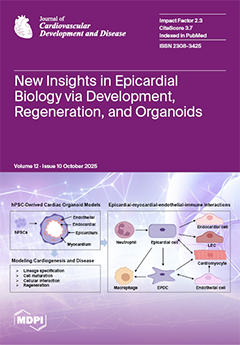Left ventricular (LV) hypertrabeculation is increasingly recognized as a phenotype that may reflect physiological adaptation, particularly in athletes exposed to chronic overload, although its functional relevance remains uncertain. This study evaluated the prevalence of excessive trabeculation and its physiological correlation with LV remodeling.
[...] Read more.
Left ventricular (LV) hypertrabeculation is increasingly recognized as a phenotype that may reflect physiological adaptation, particularly in athletes exposed to chronic overload, although its functional relevance remains uncertain. This study evaluated the prevalence of excessive trabeculation and its physiological correlation with LV remodeling. We conducted a single-center, cross-sectional study involving 320 Olympic-level athletes without cardiovascular disease. All underwent cardiac magnetic resonance (CMR). Hypertrabeculation was defined by the Petersen criteria. Athletes meeting these criteria were classified as hypertrabeculated and compared with non-hypertrabeculated matched for age, sex, and sport category. LV morphology, function, strain parameters, and hemodynamic forces (HDFs) were analyzed. Hypertrabeculation was identified in 9% of the cohort. No significant differences were observed between groups for training exposure (
p = 0.262), body surface area (
p = 0.762), LV volumes (end-diastolic volume indexed
p = 0.397 end-systolic volume indexed
p = 0.118), ejection fraction (
p = 0.101), mass (
p = 0.919), sphericity index (
p = 0.419), myocardial wall thickness (
p = 0.394), tissue characterization (T1 mapping
p = 0.366, T2 mapping
p = 0.833), global longitudinal strain (GLS
p = 0.898), global circumferential strain (GCS
p = 0.219), or HDFs. All values were within the normal range. In our cohort, LV hypertrabeculation, evaluated by CMR, was relatively common but not associated with structural or functional abnormalities, supporting its interpretation as a benign variant in asymptomatic athletes with normal cardiac function.
Full article






